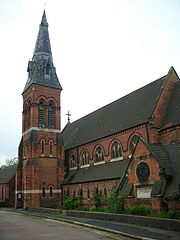
Hay Mills
Encyclopedia

Small Heath, Birmingham
Small Heath is an inner-city area within the city of Birmingham, West Midlands, England. It is situated on and around the A45 ....
in east Birmingham
Birmingham
Birmingham is a city and metropolitan borough in the West Midlands of England. It is the most populous British city outside the capital London, with a population of 1,036,900 , and lies at the heart of the West Midlands conurbation, the second most populous urban area in the United Kingdom with a...
, England
England
England is a country that is part of the United Kingdom. It shares land borders with Scotland to the north and Wales to the west; the Irish Sea is to the north west, the Celtic Sea to the south west, with the North Sea to the east and the English Channel to the south separating it from continental...
. It developed around a Victorian
Victorian era
The Victorian era of British history was the period of Queen Victoria's reign from 20 June 1837 until her death on 22 January 1901. It was a long period of peace, prosperity, refined sensibilities and national self-confidence...
steel wire mill.
James Horsfall and Joseph Webster
James Horsfall, a wire drawer from DigbethDigbeth
Digbeth is an area of Birmingham, England. Following the destruction of the Inner Ring Road, Digbeth is now considered a district within Birmingham City Centre. As part of the Big City Plan, Digbeth is undergoing a large redevelopment scheme that will regenerate the old industrial buildings into...
invented high tensile steel wire. He moved to Hay Mill , a disused blade and sword factory at a water mill on the River Cole
River Cole, West Midlands
The River Cole is a river in the English Midlands. It rises in Redhill, near Kings Norton, South of Birmingham. After flowing through Birmingham, it passes Coleshill, to which it gave its name. It joins the River Blythe, of which it is a tributary, near Ladywalk, shortly before the Blythe meets...
, rebuilding it as a steam-driven mill. The mill originally belonged to Hay Hall in Tyseley
Tyseley
Tyseley is a district in the southern half of the city of Birmingham, England, near the Coventry Road and the districts of Small Heath and Yardley...
. In 1855, his company merged with Joseph Webster's of Penn Mill
Penns Hall
Penns Hall is a hotel and country club operated by Ramada International on Penns Lane, Walmley, Sutton Coldfield, Birmingham, England. It is a Grade B locally listed building.- History :...
, Sutton Coldfield. He was a major manufacturer and exporter of the piano wire
Piano wire
Piano wire, or "music wire", is a specialized type of wire made for use in piano strings, as well as many other purposes. It is made from tempered high-carbon steel, also known as spring steel.-Manufacture and use:...
to Europe in 1824.
In 1853, Horsfall had patent
Patent
A patent is a form of intellectual property. It consists of a set of exclusive rights granted by a sovereign state to an inventor or their assignee for a limited period of time in exchange for the public disclosure of an invention....
ed a heat treatment process which strengthened the wire
Wire
A wire is a single, usually cylindrical, flexible strand or rod of metal. Wires are used to bear mechanical loads and to carry electricity and telecommunications signals. Wire is commonly formed by drawing the metal through a hole in a die or draw plate. Standard sizes are determined by various...
. This led to improved piano wire (giving a near monopoly), wire for making needles in Redditch
Redditch
Redditch is a town and local government district in north-east Worcestershire, England, approximately south of Birmingham. The district had a population of 79,216 in 2005. In the 19th century it became the international centre for the needle and fishing tackle industry...
, fishhooks, and umbrella frames. The firm made the armoured wire for first successful transatlantic telegraph cable
Transatlantic telegraph cable
The transatlantic telegraph cable was the first cable used for telegraph communications laid across the floor of the Atlantic Ocean. It crossed from , Foilhommerum Bay, Valentia Island, in western Ireland to Heart's Content in eastern Newfoundland. The transatlantic cable connected North America...
in 1866, using 30,000 miles of wire (1,600 tons), made by 250 workers over 11 months. The strengthened wire also made possible the construction of aeroplanes and automobiles.
Horsfall built houses and, in 1863, a school for his workers’ children. In 1873, he built a church, St Cyprian's
St. Cyprian's Church, Hay Mills
St. Cyprian's Church, Hay Mills is a parish church in the Church of England in Hay Mills, Birmingham, England. It is situated on the southern side of the main Birmingham to Coventry Road A45 at the end of a lane called the Fordrough which leads to the factory of Webster & Horsfall Ltd...
, designed by Martin & Chamberlain
Martin & Chamberlain
John Henry Chamberlain, William Martin, and Frederick Martin were architects in Victorian Birmingham, England. Their names are attributed singly or pairs to many red brick and terracotta buildings, particularly 41 of the forty-odd Birmingham board schools made necessary by the Elementary Education...
and now grade II listed, over the mill race
Mill race
A mill race, raceway or mill lade is the current or channel of a stream, especially one for conducting water to or from a water wheel or other device for utilizing its energy...
on the mill site. This developed into the village of Hay Mills.
The company today also makes springs.


Sources
- The Real History of Birmingham - Volume 2, J.P. Lethbridge, 2002, ISBN 0-9512227-7-8-3
- A History of Birmingham, Chris Upton, 1993, ISBN 0-85033-870-0
- Webster and Horsfall
- BBC article on the mill and the transatlantic cable
- National Archives - Short history
- Origins of Hay Mill and Hay Hall

